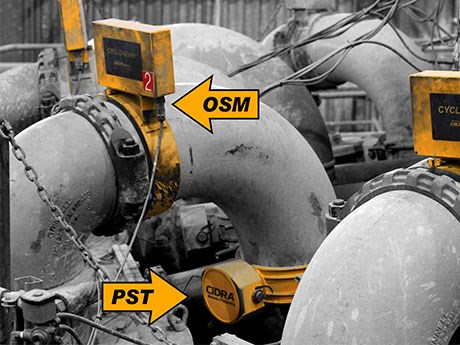Synergy Controls introduces CiDRA CYCLONEtrac products to Northern Ontario and Manitoba
Size doesn’t just matter in mineral processing. It’s of critical importance.
The sole purpose of blasting, crushing and grinding ore is to reduce particle sizes so they are small enough to expose and liberate the valuable minerals and optimize recovery.
Getting the right particle sizes for leaching, floatation or magnetic separation has always been challenging, but two new products being marketed by Synergy Controls Corp. in Sudbury promise to revolutionize particle size monitoring.
Developed by Connecticut-based CiDRA Mineral Processing Inc. at the urging of Rio Tinto, the CYCLONEtrac sensors detect oversize particles and report on particle sizes spun out of hydrocyclones on their way to floatation cells.
A battery or cluster of hydrocyclones sits between the grinding and separation processes, explains Christian O’Keefe, chief technology officer for CiDRA.
“The slurry comes in through the side of the hydrocylones and swirls around in a circular pattern at a very high speed, setting up a centrifugal force. The larger particles migrate to the outer portion of that flow and to the bottom of the hydrocyclone and return to the ball mill for further grinding.”
The smaller particles spin to the top of the hydrocyclone into the overflow and from there to the floatation cells, but due to the nature of the ore, the operating conditions or damage and wear to the hydrocyclones, larger particles called pebbles or stones up to a half-inch in diameter often come through the overflow for downstream processing, said O’Keefe.Rio Tinto asked CiDRA to develop a sensor capable of detecting oversized material coming through the overflow so they could shut down an offending hydrocyclone before too many oversized particles accumulated in the floatation cells.
Oversize detection
The result is the CYCLONEtrac OSM, which wraps around and is clamped onto the top of the overflow pipe from each individual hydrocyclone. As the oversized particles a quarter-inch to half-inch in size (6 to 10 millimetres) come around, they impact the pipe wall and are detected by the sensor.
Rio Tinto also challenged CiDRA to come up with a second sensor that could provide mill operators with a better idea of the particle sizes entering the overflow. This second sensor called the CYCLONEtrac PST is a probe that goes into the overflow pipe and reports on the percentage of material exceeding the target size.
“If it’s 20 per cent above the target size, that may be fine,” said O’Keefe. “If it’s 50 per cent, it’s not fine. Anything between 25 and 30 per cent is a problem because mineral recovery goes down.”
The CYCLONEtrac PST provides onesecond updates, so it’s constantly measuring the particle sizes entering the overflow from each individual hydrocyclone. Armed with this information, mill operators are better able to make adjustments and optimize the entire grinding and separation process Currently, some mills collect sample material from the overflow every few hours for laboratory analysis, said O’Keefe.
“Other plants have particle size analyzers that take a sample once a minute or once every three minutes from the common flow of all the cyclones, but these particle size analyzers have a very poor uptime rate, meaning they’re plugged, not working right, need to be calibrated and not giving good information…or any information.
“They don’t know what each hydrocyclone is doing because they’re sampling off all the hydrocyclones
in a pack, and it’s not real time.”
The information captured by CiDRA’s CYCLONEtrac sensors is conveyed to the mill’s distributed control system and displayed in the s control room.
The display identifies the status of each cyclone, reports on rocks and pebbles coming through and provides a 24-hour history of particle sizes.
If there are problems with a cyclone, they can shut it down and let it drain out if it’s plugged, said O’Keefe. If they turn it back on and the problem persists, they’ll take it offline for servicing.
“If they see rocks coming through from most of the cyclones in a battery, they know it’s not a cyclone issue. It could be due to the nature of the ore coming through in which case they may have to operate the grind circuit differently.”
Testing and deployment
Both CYCLONEtrac products were beta tested and are up and running at Rio Tinto’s Kennecott concentrator in Salt Lake City, Utah.
They were introduced to the market at the SME 2014 Meeting and Exhibits in February in Salt Lake City and a second CYCONEtrac OSM system has since been deployed in Chile.
In the absence of more precise particle size information, mill operators have traditionally tried to get the right size material by setting the pressure on the cyclones and the density of the material, but that doesn’t always work out, said O’Keefe.
The better alternative is to go for a set particle size and then adjust the pressure and density to achieve it, “so it’s really turned everything around on how they operate.”
Synergy Controls is the authorized CiDRA distributor for Northern Ontario and Manitoba.



